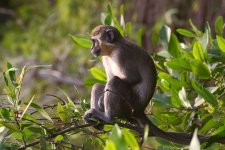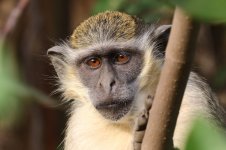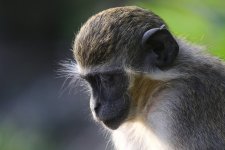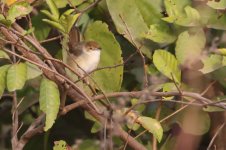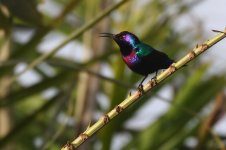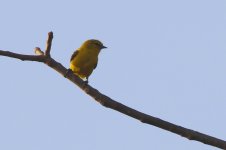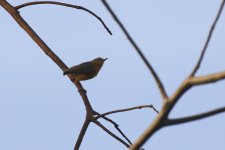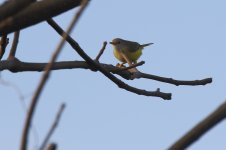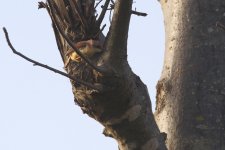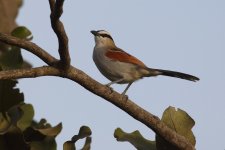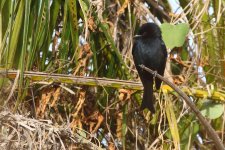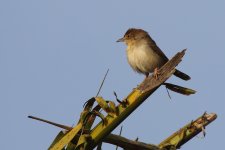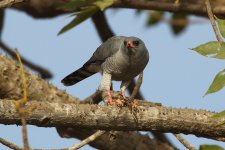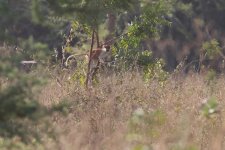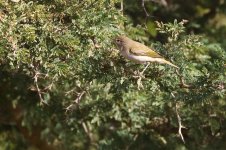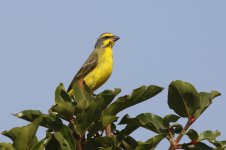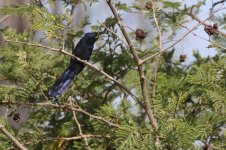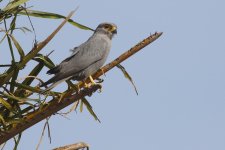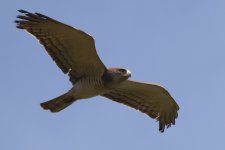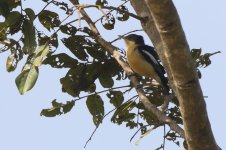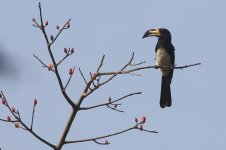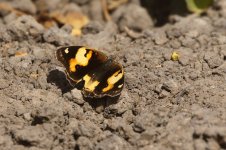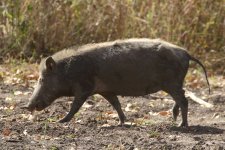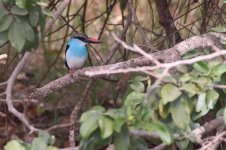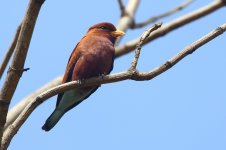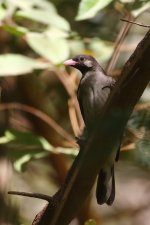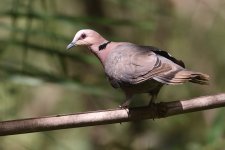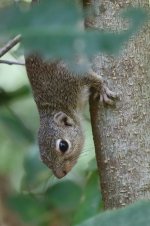Thank you Richard!
Time for another instalment.
Day 3: 9 January
At least one bat was still singing when we got up but had stopped by the time we were outside and heading for breakfast. For some unaccountable reason I had a slightly thick head this morning but it didn't put me off my food: I probably did drink more tea than the previous day though.
Another tussle with the rush hour and we were once again on the road out of town past the airport. Unfortunately I still don't know where we made our first official stop, but almost as soon as we were out of the car we hit a mixed species feeding flock and for a few minutes it was absolute bedlam. Not only that but the light was as usual coming from an awkward direction so I moved away from the group to improve it and just shot photos of as much as possible as fast as possible while listening all the while for Ebrima calling species names so I could make sure of not missing any ticks.
A fly-by African Harrier-Hawk (for me you can take "Gymnogene" and stuff it) was immediately followed by a fly-through African Golden Oriole, perpetuating that species' habit of being unphotographable (by me, anyway). Then in quick succession a Northern Crombec bounced up into a dead tree, joined by a Little Weaver (tick) male Splendid Sunbird that actually sat in the right light for a picture, Beautiful Sunbird, Red-winged Warbler (tick), Black-crowned Tchagra, Yellow Penduline Tit (tick) and at least one Double-spurred Francolin (tick) that legged it off down the track nearby and vanished into the bushes. There were also Tawny-flanked Prinias and other common species such as Grey-backed Camaroptera, and a Senegal Eremomela that was another tick. As things calmed down we headed off down the track led by Ebrima who then found us a Singing Cisticola (tick). I've heard some very disparaging words about Cisticolas but personally I quite like them - the worst is still miles better than a Blyth's Reed Warbler.
Following the Cisticola as we proceeded on our first "short walk" of the day we turned off the track and then came upon a large flock of assorted Bishops that included both Northern Red Bishop (a tick, my only other one having been years ago at Stanpit while dipping a Little Crake) and Black-winged Red Bishop, as well as a number of Northern Grey-headed Sparrows (whoopee - no, only joking. They were a tick though.) A Glossy-backed Drongo (recent split and therefore a tick) sat above them watching for insects. The Bishops seemed settled but a Gabar Goshawk flashing into the middle of them fixed that! It also fixed one of the Bishops and took it up into a nearby tree to eat, which it proceeded to do without actually finishing it off first, so that for the first part of the meal it was still moving feebly. Slightly gruesome. Didn't stop us photographing this fine raptor, though.
The usual passing Hooded Vultures were now upstaged in quick succession by a Dark Chanting Goshawk, a Western Marsh Harrier (or as we say, Marsh Harrier) and a fine local Grey Kestrel that was a much appreciated tick. All of those were then upstaged by a brief sighting of some very, very, jittery Patas Monkeys at long range (I think only I raised a camera). We never got good views of these. It appears to me that they are very nervous of humans and I must unhappily conclude that at the very least they are driven off from crops and most likely, victims of real persecution.
What was turning into another long trek under the increasingly hot sun produced another flock of seed-eating birds, this time mostly composed of Red-cheeked Cordonbleus and Yellow-fronted Canaries, some of which sat up for photos. We also encountered a quite accommodating Black Scimitarbill that foraged in some very spiny acacias enabling photos before finally disappearing behind them. A Western Bonelli's Warbler was an interesting diversion in one of those acacias.
Back at the car after our short walk we headed off with the conversation centring around spotting stuff from the car, particularly raptors. Steve as the most travelled was relating previous experiences in which people achieved legend status by picking out a special bird at sixty mph, or disgraced themselves by misidentifying something seen all the time and causing an unnecessary stop. He then saw something he thought mattered and we quickly stopped and disembarked. Would his reputation survive?
The bird had sunk below the treeline but Ebrima decided it was worth a short walk and away we went. Luckily the bird came straight for us and we had an excellent close fly-by followed by circling a little further away, from a Beaudouin's Snake Eagle. Photos an' all: cracking views, cracking pix, cracking bird, cracking tick. Steve's rep intact! Interestingly, we had seen a snake eagle at the first site the previous day but put it down as Short-toed: when I revisited the photos after returning to the UK it was apparent that it, too, was a Beaudouin's - Short-toed off the trip list!
Walking on through the woodland we could hear European Bee-eaters above us. Ebrima's attention had sharpened as a guide's will when they are onto something, and he suddenly pointed upwards. "Yellow-bellied Hyliota" he announced. Big bird for Steve, not many ticks for him in Gambia but this was one of them (and obviously for the rest of us!) and now he had one of those desperate melt-down moments before getting onto the bird as it moved slowly through the upper branches. Luckily it paused for a bit of a preen and we all had good views as well as getting a few pictures.
Not long after that we reached the edge of the woodland and beyond it, in an isolated tree among hard-baked fields with intermittent bushes, sat a huge African Pied Hornbill, which was a tick for me and also sat tight to allow photos of its curious, casqued head-shape. Excellent!
Scouring the more open ground found us little apart from fairly distant views of the European Bee-eaters, but little else till we returned to the road and managed poor views of Northern Yellow White-eye (tick) in a fruiting tree next to where we had emerged, as well as a fly-over from a Palm-nut Vulture - another tick and my second-to-last African vulture sorted (Lammergeier still required), while we waited for Karanta to fetch the vehicle up to us. Our next destination would be another sit-down one and it was rumoured lunch would also be involved.
John




